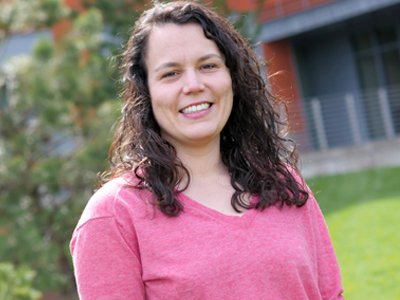Biology Graduate Student Awarded East Asian Research Fellowship
Fellowship supports summer research on plant physiology in Japan

Second-year biology Ph.D. student Kelsey Martinez was recently awarded a National Science Foundation (NSF) fellowship to spend her summer researching plants in Japan. The East Asia and Pacific Summer Institutes (EAPSI) fellowship is co-funded by the Japan Society for the Promotion of Science and covers all travel and lodging expenses, in addition to a stipend and research supply funding.
Martinez’s research compares the physiology and function of different plants, particularly differences in leaves’ efficiency at gathering carbon and turning it into sugar. She makes these comparisons in locally occurring native North American plants and invaders from East Asia. The fellowship enables Martinez to investigate the invaders’ leaf physiology on their home turf.
In response to Martinez landing this competitive award, her advisor, Jason Fridley, says, “Kelsey has made rapid progress in her thesis work and this is reflected in her grant success in only her second year.” He continues, “It demonstrates how hard she's worked, not just in gathering preliminary data that were essential to the proposal, but also in making international contacts that will help put her in the top echelon of scientists working on invasive plant function."
While in Japan, Martinez will be working with Kouki Hikosaka at Tohoku University in Sendai. She looks forward to developing new chemistry skills to investigate how leaves use a limited resource—nitrogen. “It's really exciting that Dr. Hikosaka has agreed to help me learn the chemistry to analyze leaf nitrogen allocation and leaf anatomy, since he's both an expert and a pioneer in this area,” she says.
Gaining chemical analysis skills will be particularly important for Martinez’s dissertation. Her overall research goal stems from a key difference between native North American plants and invasive species from East Asia. During photosynthesis plants capture energy from the sun to convert carbon into sugars, but the invaders do a better job of it than North American locals. The end result of this imbalance is invasive species out-competing local plants and threatening local ecosystems—and Martinez wants to know why.
“I will be measuring photosynthetic rates and comparing chemical processes in leaves to understand how invaders use nitrogen, a scarce resource, to capture energy,” Martinez says. She also points to a hypothesis for disproportionate invasive plants’ success: “We think invaders might have different leaf traits or nitrogen use strategies that allow them to capture more energy than our North American species.”
Martinez will be focusing on shade-loving plants, including Japanese honeysuckle, Japanese barberry and burning bush. She will be making comparisons between how leaves function in these North American invaders as compared to other Japanese plants that are not invasive. In addition, Martinez will be investigating if the invaders are behaving differently in their home territory than they do in North America. She hopes these comparisons will lead to a better understanding of why invasive species are a threat to local ecosystems.
Of the fellowship, Martinez say, “I am most looking forward to establishing a collaborative relationship with a well-respected ecophysiologist and the opportunity to experience research culture in a different country.” She adds, “And of course sightseeing and eating as much delicious Japanese food as I can!”
